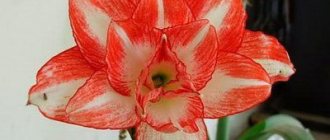Many flower growers are very fond of such a flower as chrysanthemum. It is popular and can grow both in open ground and at home. In the latter case, a pot is used to grow the flower. Caring for it both indoors and outdoors will be exactly the same, only unlike garden chrysanthemums, indoor chrysanthemums are small in size. So how to care for a chrysanthemum in a pot? Let's try to figure this out.
Features of indoor chrysanthemums
This flower can be either annual or perennial. It has a branched root system, the development of which occurs parallel to the surface. The leaves of the plant are light green and are dissected, serrated or notched. A dense inflorescence is formed by small flowers collected in a basket.
Indoor chrysanthemum has a large number of varieties that grow wonderfully at home. These types differ from garden ones in their miniature size. This is explained by the fact that for growing indoors they use drugs that stop their growth for decorative purposes. When purchasing a chrysanthemum for growing in pots, you should choose a strong and healthy specimen with a well-formed stem and dense foliage. After purchase, the flower adapts to new conditions for some time. To prevent the plant from becoming infected with diseases from other indoor flowers, it is quarantined for several days.
Chrysanthemum in a pot: proper care
Watering
Chrysanthemum is very moisture-loving, but you can’t overdo it. The soil in the pot should always be moist, but not soggy. The ideal watering regime is twice a day in such an amount that the leaves of the flower are dry by the next morning. In other periods, you can use a spray bottle, regularly spraying the leaves of the flower. Chrysanthemums love this type of care.
Temperature
Chrysanthemum prefers cool temperatures and short sunny days. The ideal temperature for better preservation of the inflorescence is 15 degrees. Acceptable, but the maximum is 18 degrees. If the temperature is higher, the leaves will often turn yellow, the buds will dry out, and the flowering period will quickly end. Recently purchased and not yet established plants are more susceptible to such negative consequences of rising temperatures.
Despite the fact that chrysanthemum needs a short daylight hours, about 8 hours, it is a light-loving plant. Therefore, you should not hide it in the shadows. But also protect it from direct sunlight.
Lighting
Ideally, domestic chrysanthemums should be kept on windows facing west or east. Southern windows are too hot for them; direct sunlight causes rapid flowering. On northern windows, the buds may not open at all. Alternatively, chrysanthemums at home can be placed on a ventilated, cool balcony with good lighting.
Chrysanthemum is a plant of short daylight hours. Flowering begins when daylight hours are reduced to 8-10 hours. And this happens in the fall. Then the coolness necessary for the opening of chrysanthemum flowers appears. Similar conditions may occur in early spring, in March-April. If at this time you place your home chrysanthemum on a cool balcony, then spring flowering is possible. Some amateur flower growers provoke the flowering of their chrysanthemums by artificially reducing daylight hours. To do this, after the required 8-10 hours, the plant is covered with an impenetrable cap, for example, made of cardboard.
Air humidity
Chrysanthemum loves moisture, so do not allow the soil, and therefore the root system, to dry out. Maintain constant moisture. Spray it from above occasionally. During flowering, it should be fertilized with special food for flowering plants.
Why don't chrysanthemums bloom?
Why doesn't chrysanthemum bloom outside? There may be several reasons for this. Despite the fact that this flower is a garden and perennial, it does not always feel good outside, and, as a result, does not bloom. What can negatively affect chrysanthemum? This:
- crowdedness;
- wrong location;
- insufficiently nutritious soil;
- abundant watering during the formation of buds;
- diseases.
In addition, the flowering ability of different varieties of flowers is not the same. Perhaps the climate is simply not suitable for a certain flower. Let's consider all the reasons separately, as well as ways to eliminate them.
Why doesn't chrysanthemum bloom outside? She simply may not have enough space. Over time, the bushes grow, which reduces the amount of soil occupied by each plant. Due to this, the flowers begin to lack air and nutrients. Pests can grow in the thicket of bushes. Ideally, chrysanthemums should not grow in one place for more than 2-3 years.
Don't be afraid to replant chrysanthemums often. These flowers grow new shoots very quickly. Often after transplantation they grow even better than before.
It is best to plant chrysanthemums in the spring. This will give the plant the opportunity to take root well, grow and bloom in the fall. For the plant, you should choose a high place that is well blown by the wind. This will ensure the absence of dampness, which chrysanthemums do not like so much. Also keep in mind that the soil must have drainage.
When planting chrysanthemums, make sure that there is at least 40 centimeters between plants. This will just give free space for flowers. It will become easier for them to grow and by autumn they will definitely bloom.
Why doesn’t a chrysanthemum bloom outside if it doesn’t face a lack of space? Perhaps you just chose the wrong place to plant them. The number of buds is affected by lighting. If there is too little of it, the flower will suffer. Excess moisture also affects the chrysanthemum. It can cause the flower to become covered with fungus and other pests, which also interferes with normal flowering. But too dry living conditions are also not suitable for violets. They can provoke woodiness of shoots and lack of flowering.
A disruption in biorhythms also prevents the chrysanthemum from blooming. It can be provoked by garden lights. The flower reacts to light and thinks that the day continues. And since it is long enough, it means autumn, which is the time of flowering, has not yet arrived.
Transplanting chrysanthemums to another place where the soil is fresher and more nutritious is certainly effective. But such a suitable place cannot always be found. And sometimes there is not enough time for such manipulations. If you find that the chrysanthemum does not bloom even in October, then replanting will no longer help. After all, while the flower takes root, cold weather will set in. In this case, feeding remains.
How can you fertilize the soil to make chrysanthemums bloom? First, before planting plants in the holes, you need to add compost or humus. This will allow the flowers to receive the maximum nutrients and take root quickly. After the chrysanthemum has grown for 2-3 years, it is important to start fertilizing the soil around it.
It is the lack of nitrogen that is most often to blame for the fact that chrysanthemums do not bloom in the garden. In this case, its leaves begin to turn pale, sometimes the covers of the stems become sparse, as well as the buds.
Why don’t chrysanthemums bloom in the country if they have enough nitrogen? In this case, there may not be enough phosphorus in the soil. It is this mineral that promotes abundant and timely flowering. In addition, it contributes to the long-term preservation of cut flowers. Lack of phosphorus provokes underdevelopment of bushes. Leaves may turn purple-blue.
It is better to apply phosphorus in the spring. But if for some reason you did not have time to do this, then you can do autumn fertilizing in liquid form. In this case, you need to be careful with nitrogen; its volume can be reduced.
Chrysanthemums also need potassium. If there is a severe shortage of it, the buds may not appear at all, and the bush itself will begin to dry out and shrink. If flowers appear on such a plant. Then they will be of irregular shape, with violations of varietal characteristics. At the same time, an excess of potassium is also harmful. This is worth remembering. It is better to add the mineral along with phosphorus.
You should not apply too much fertilizer, because chrysanthemums may begin to “fatten”. They will begin to grow and send out a lot of young shoots. The bush will grow huge, but there will be no flowers.
Flower growers advise fertilizing the soil not only when negative signs are very noticeable or there is no flowering, but regularly, approximately once every 10-15 days. You should start in early spring. At this time, it is better to give preference to nitrogen fertilizers, but in the fall - potassium and phosphorus fertilizers. Substances can be combined.
When applying fertilizer, try not to get it on the lower leaves of the flower, as they can be burned. It is better to wet the soil around the chrysanthemum, and then pour in liquid fertilizer. This way the procedure will be safe.
Abundant watering
Do not think that during the flowering period chrysanthemum requires a lot of moisture. In fact, it's the opposite. If you notice buds forming, reduce watering. Otherwise, the plant will start flowering and begin to grow stems and large beautiful leaves.
We suggest you read: Is it necessary to make a blind area around the house?
Propagation of indoor chrysanthemum
This flower is propagated by cuttings or by dividing an already mature bush, and it can also be grown from seeds. To get cuttings, choose the plants you like, and after the chrysanthemum has faded, cut off all the shoots that are on top of the ground. Then the pot with the root remaining in the ground is placed in a cool place for the entire winter period, not forgetting to water the plant. In March, the expected cuttings will begin to appear from the ground, which need to be cut and, for better rooting, immediately planted in a box with prepared soil from a mixture of humus and peat, and this mixture should be covered with sand on top, into which chrysanthemum cuttings are planted shallowly. Then they need to be sprayed with water, covered with glass or film and the box placed in a cool room with a temperature of 13-15 °C for 3 weeks. After rooting, young plants are transplanted into small pots, and as they grow, the chrysanthemum is replaced with a larger pot.
Diseases and pests of chrysanthemum
Chrysanthemums, like other indoor flowers, are the object of love for many parasites and diseases:
- Spider mite. If cobwebs are detected on the leaves, the entire surface of the plant is treated with a soap solution, and then washed under warm water in the shower.
- Powdery mildew. A fungus in the form of a gray coating on the leaves of a plant. It is eradicated using a fungicide and quarantining the plant in a dry room.
- Gray rot. It appears as a fluffy layer of gray color on the sheets. You can remove it by spraying the leaves with foundationazole.
- Septoria. It looks like a brown spot on a plant leaf. The plant needs to be watered less and treated with foundationazole.
Indoor plants are not small copies of garden forms
- the plant has a shallow root system, so it cannot be planted in narrow and high pots. At the same time, flat, wide bowls are also not the best option: it is difficult to organize good drainage in them, which is so necessary for proper air exchange of thin and delicate roots;
- when replanting, the new pot should be slightly larger than the previous one so that the root system has room to develop;
- chrysanthemums can be grown in pots and flowerpots made of any material, but they look especially impressive when kept in massive clay or ceramic pots.
Pests
The main pests of indoor plants that gardeners may encounter are:
- Spider mite. It is dangerous because it very quickly sucks out all the juices from the ground part of the flower, as a result of which it withers and dies. The presence of an insect is signaled by the appearance of thin cobwebs on the lower parts of the leaves. Experienced flower growers know how to save a chrysanthemum in a pot from this trouble. To prevent spider mite infection on hot days, the bushes are periodically sprayed with clean water. At the first sign of a pest, the leaves are treated with a weak soap solution. If the mite has managed to spread throughout the entire bush, only special insecticidal preparations (Fitoverm, Akarin, etc.) will help get rid of it.
- Field (meadow) bug. You can even detect this parasite on a home chrysanthemum with the naked eye: the field bug is gray-green in color, reaches a length of 0.5 cm and settles on the leaves. The insect draws juices from the above-ground parts of plants, which leads to yellowing and curling of the leaves. Specimens affected by bedbugs stop blooming and develop poorly. If the bugs have not yet had time to breed, they are destroyed along with the affected foliage; in case of severe infestation, they are treated with insecticides.
- Aphid. Another pest that feeds on plant sap and reproduces very quickly. The invasion of these parasites can completely destroy a flower in a short time. Aphids appear on domestic chrysanthemum if the bush is regularly watered. You can fight it mechanically, promptly tearing off leaves and stems with signs of infection, but a more effective method of treatment is the use of modern insecticidal preparations.
Diseases
The diseases that most often affect domestic flowers include:
- Powdery mildew. It appears in the form of a light powdery coating that gradually covers the above-ground part of the plant. Its causative agent is a fungus that becomes active during prolonged high humidity. White coating on the leaves is one of the main reasons why chrysanthemums in pots wither. There is no point in washing it. To get rid of powdery mildew, the affected parts will have to be removed completely, after which the bush must be treated with any fungicidal preparation.
- Septoria. The first sign of this disease for indoor chrysanthemums is the appearance of yellow spots on the lower leaves. Without treatment, the spots turn brown and eventually turn black. The disease can spread throughout the plant, it dries and dies. To prevent this from happening, it is necessary to promptly remove all affected parts, and then spray the bush with a fungicide.
- Withering. A disease that occurs when a soil fungus activates and manifests itself first in the loss of turgor in the leaves, then the foliage turns yellow and dries out. Replanting it in fresh soil and treating it with a fungicide will help revive the plant.
Another reason why chrysanthemum leaves turn yellow in an apartment may be errors in care. Lack of light, over-drying of the earthen ball in the pot, too dry air and exposure to heating devices - this is an incomplete list of factors that significantly worsen the appearance of a green pet.
Read more: Blestyashchiy grapes description of the variety, features of cultivation
Flower growers often have to deal with the question: why do the leaves of indoor chrysanthemums dry out? The cause of this phenomenon can be either fungal diseases or a violation of the watering regime and normal air humidity.
All articles about chrysanthemums on the site can be read by following this link...
Caring for indoor chrysanthemums is actually not at all difficult. They are quite patient, able to withstand unfavorable external conditions and transplantation into open ground. However, chrysanthemum will delight only those who spare no attention and care for it with its lush, long-lasting flowering and positive energy.
Very often chrysanthemum is affected by powdery mildew. A gray coating appears on the leaves and peduncles. Powdery mildew appears when air humidity is excessively high. In this case, caring for indoor chrysanthemums includes treating the plants with fungicidal agents.
If gray-ashy plaques with a fluffy surface appear on the bush, these are symptoms of gray rot. The leaves turn brown at the edges. Brown spots appear on them. To get rid of this problem, the bush is sprayed with foundationazole and moved to a well-ventilated and lit place.
When the air is too dry, red spider mites settle on the flower.
A common disease of chrysanthemums is septoria. It is characterized by the appearance of brown spots that have a yellow border. To cure the plant, you need to reduce watering and eliminate spraying for a while. The bush must be treated with foundation.
This type of care for indoor chrysanthemums allows you to grow healthy, strong and lush flowering bushes.
Chrysanthemums, like other indoor flowers, are the object of love for many parasites and diseases:
- Spider mite. If cobwebs are detected on the leaves, the entire surface of the plant is treated with a soap solution, and then washed under warm water in the shower.
- Powdery mildew. A fungus in the form of a gray coating on the leaves of a plant. It is eradicated using a fungicide and quarantining the plant in a dry room.
- Gray rot. It appears as a fluffy layer of gray color on the sheets. You can remove it by spraying the leaves with foundationazole.
- Septoria. It looks like a brown spot on a plant leaf. The plant needs to be watered less and treated with foundationazole.
Street chrysanthemums are sold in plastic containers. Such flowers are planted in open ground or left in a container, used for container gardening, patio decoration, and entrance to the house. After flowering, the stems are cut off, and containers with roots are sent to the basement or loggia for the winter. If an outdoor chrysanthemum is kept indoors, its leaves will turn yellow and dry out. These plants need fresh air and a certain lighting regime - the night is longer than the day.
After the death of the pests, change the top layer of soil in the pot to a depth of 2 cm. It is recommended to be careful when choosing a substrate. Typically, pathogens and plant pests are contained in soil brought from the garden.
It is very important to isolate the affected plant from the rest of the green pets in the room and to carry out pest and disease control in a timely manner. Then the chrysanthemums will remain healthy and will delight you with flowering for a long time.
Possible problems:
- Chrysanthemums in a pot have wilted
Like other plants, chrysanthemums wither due to improper care or disease. Perhaps it was not moistened enough, or, on the contrary, it became damp and began to rot. It is necessary to change the conditions of keeping the chrysanthemum.
- Why doesn't a chrysanthemum bloom in a pot?
Chrysanthemums bloom only in autumn. Problems with flowering can occur for the same reasons as wilting. It is necessary to reconsider flower care based on basic recommendations.
- Dried chrysanthemum in a pot
If you do not remove drying leaves and flowers from a chrysanthemum during the flowering period, the entire plant may dry out.
Why doesn't chrysanthemum bloom?
Any chrysanthemum should bloom in the fall. This law can only be violated if there are errors in caring for the plant. The most common of them are:
- Poor illumination (low intensity of light rays, too long (more than 10 hours) or, conversely, short (less than 7 hours) daylight hours).
- Late pruning (pinching).
- Poor soil and lack of fertilizing (containing phosphorus and potassium).
Eliminate the errors found and your potted chrysanthemum will definitely thank you with lush and long flowering.
Dependence of chrysanthemum variety and its flowering
The flowering of chrysanthemum plants in late autumn is stimulated by reduced daylight hours. That is, when it starts to get dark early, these flowers lay buds. Flowering itself begins in late autumn. But here it is worth noting that different varieties of chrysanthemums lay buds at different rates. If you have a late variety plant, then there is a high probability that all this will happen too late. The flower simply will not have time to appear before you in all its glory. The cold weather will come and the buds will remain just buds. Therefore, before buying cuttings, carefully check the characteristics of the varieties. After all, perhaps the flower you like cannot grow normally in the local climate.
What to do if you have already bought a late variety chrysanthemum? There is a way out in such a situation. The plant will bloom if you plant it not outside, but in a greenhouse, greenhouse, or just in a flower pot. You can plant the cuttings in a flowerpot initially, immediately after purchase.
You can also transplant from the street if the plant has already taken root, and later you realized that it does not have time to bloom. Simply dig up the cuttings and transplant them into a prepared container.
It is worth noting that all chrysanthemums that are sold at the end of October-November are greenhouse ones. They are grown specifically for bouquets. You should not hope that flowers of these varieties will bloom luxuriantly in your outdoor garden.
Useful tips
How to care for a chrysanthemum so that it is lush? To do this, it is cut and pinched. This procedure is carried out throughout the entire growth period. If this is not done, the plant will have a long, unsightly looking stem. To extend the flowering period, it is necessary to remove dried leaves and flower buds from time to time. On hot days, the flower is placed in a cool place. Many gardeners prefer to plant chrysanthemums in open ground before autumn. For the winter it is planted again in a pot.
Thus, caring for indoor chrysanthemums at home is not so difficult. When growing it in a pot, you should adhere to certain rules and promptly get rid of pests and diseases. Only in this case will the flower grow healthy and strong, delighting its owner with abundant flowering.
Diseases
The plant begins to wither when the microclimate is not suitable for it and the conditions of its maintenance are violated.
No flowering
Why chrysanthemum grows but does not bloom, there are 2 reasons:
- Lack of light. Do not place the pot in a dark place in spring and summer, otherwise the bush will not bloom in the fall.
- Lack of nutrients or their excess. Use fertilizers in a timely manner, but do not overdo it with fertilizers.
Leaves wither
Chrysanthemum may wilt due to lack of watering. Always monitor the soil moisture in the pot. Increased temperature in the house also contributes to the wilting of plant leaves. Monitor the microclimate to save the flower.
Dew
The white coating is caused by powdery mildew. It occurs due to high temperature and humidity in the house. To avoid this, it is recommended to ventilate the room. In order to stop the spread process, remove the affected leaves and treat the chrysanthemum with phytosporin.
Important: Powdery mildew is contagious. Remove the diseased flower from healthy plants until it is completely cured.
Rust on leaves
This disease manifests itself as yellow spots that turn brown, and then the chrysanthemum leaves curl. Rust also appears at high temperatures and humidity. Treatment occurs with the help of fungicides; before this, damaged leaves are removed and the flower is removed from others for quarantine.
Spots on leaves
Septoria spotting is manifested by the appearance of round black spots.
In this case, nothing can help the chrysanthemum, and it must be burned. To prevent this disease, treat the plant with preparations containing copper. Home flowers decorate the interior, creating a pleasant atmosphere and comfort. You learned from the article how to care for a chrysanthemum and make it bloom. Follow all the above rules so that the beautiful chrysanthemum will delight you not only in the garden, but also at home.
How to preserve chrysanthemums in winter?
In winter, the chrysanthemum should rest and gain strength before the new growing season. You can overwinter the plant:
- In a bright, cool room (on the veranda, insulated balcony, in the entrance). After flowering, the potted chrysanthemum is cut to 10-15 cm and placed in a cool, bright room for the winter. The optimal temperature is 3-8°C. Water the plant rarely, only after the clod of earth has dried out on 2 phalanges of the finger. Typically, watering is required once a month.
- At home. If there is no cool room, the chrysanthemum can remain on the windowsill in the house in winter. In this case, the plant is pruned minimally, with the obligatory removal of faded buds, dry branches and leaves. Watering is carried out in the same way as during the growing season.
- In the basement. Chrysanthemums can be placed in the basement for the winter. This method is very popular among owners of garden heat-loving chrysanthemums, and therefore is quite suitable for their potted counterparts. To prepare the plant for wintering, all dried branches, flowers, and rotten parts are cut off. The bush is trimmed to a height of 10-15 cm. A couple of days before the start of wintering, the soil in the pot should be watered. By the time the chrysanthemum is placed in the basement, the soil should be slightly damp, but not damp.
- In open ground. Some varieties of potted chrysanthemums are able to overwinter in the ground with shelter. Another thing is that it is very difficult to guess whether a particular specimen will overwinter. If you decide to take the risk, with the onset of the first frost, cut the chrysanthemum stems to a height of 10 cm and cover them with dry soil, peat or dry leaves. On top - cover with film or other covering material.
Potted chrysanthemums: planting in open ground
In the warm season, indoor chrysanthemums will benefit from being on the balcony or in the garden. If you want to effectively decorate your flower beds, transplanting chrysanthemums from a pot into the ground is not at all necessary. You can simply take them out onto the terrace in beautiful flowerpots and flowerpots, or dig them into the garden directly in pots, and take them back home when the cold weather arrives.
When the question of how to transplant chrysanthemums from a pot into the ground is still relevant, the main thing that needs to be done is to choose the right planting site. The better it is lit, the more comfortable the flower will be in open ground. The time when you can transplant the bush outside comes when the last morning frosts have passed. The soil must be warmed up to at least 14 °C. In this case, adaptation to new growing conditions will be faster.
Hello!
Victoria.
Expert's answer
Even when purchasing a chrysanthemum in a flower shop, there is a risk of receiving false information about the varietal properties. Some hybrids can be recognized by characteristics that only specialists will notice. Resistance to cold and pests may not be what the buyer expected.
If it turns out that already planted garden chrysanthemums are adapted to other climatic conditions, you can try moving them into containers and growing them indoors. Many varieties easily tolerate such changes.
Since these are bush plants, they need room to branch and form buds. They may compete with other flowers or suffer from dominance by more resistant neighbors. For chrysanthemums, you need to choose a well-lit area with partial shade, reliably protected from strong winds.
Lack of fertilizer is often the cause of untimely flowering. Poor soils are simply not able to provide the plant with minerals. To stimulate the formation of buds and full flowering, it is enough to properly feed the plant in August.
Phosphorus-potassium fertilizers have proven themselves best.
In addition, it is worth taking care of fertilizing in advance even when planting the bush. You can use all-purpose or organic mixtures. The soil for these flowers should be moderately moist to prevent root rot. It is advisable to ensure a loose soil structure for sufficient saturation with air and liquid. Chrysanthemums prefer neutral acidity and are especially sensitive to acidic soils.
Most varieties are light-loving; they require 7-10 hours of daylight. If such conditions cannot be ensured on the site due to weather fluctuations, then tricks with partial shading or lighting may be needed. When growing in a pot, you need to monitor the condition of the plant, do not leave it in direct sunlight, and, if necessary, use phytolamps.
A lack of fluid is easier to tolerate than an overflow, but you need to take into account the type of soil and air temperature. As a rule, the procedure is carried out three times a week. Indoor chrysanthemums are watered in the same way as other house plants - as needed.
Any plant can become a victim of pathogens due to improper maintenance conditions and will simply not be able to bloom. Insects and bacteria come from open ground, and indoor chrysanthemums suffer from spider mites and aphids. The development of diseases can be prevented by timely prevention.
The most effective method in such a situation is pruning. It is carried out both for young plants and for those that have been living in one place for several years. In early spring, tall peduncles are cut to form a bush of the desired shape, stimulate and accelerate the formation of new buds.
Trying to find a method to make garden and indoor varieties bloom, many gardeners pay attention to the condition of the soil and temperature fluctuations. Sometimes it is enough to warm the flower a little so that the inflorescences appear at the right time. Reducing the amount of nitrogen fertilizers, which are used more to increase the green mass of the bush, can also help.
Homemade chrysanthemums: care in spring and summer
Already in March, home chrysanthemums should begin their growing season. Therefore do the following:
- Replant the chrysanthemum in new soil. The soil for chrysanthemums must be neutral, water- and moisture-permeable, and nutritious. Very good results are obtained by planting chrysanthemums in a substrate composed according to the following scheme: turf soil + garden soil + sand + humus (rotted manure, chicken droppings) in a ratio of 4: 4: 1: 1. Young chrysanthemums will require transplanting into a new, larger pot every year. Adult plants need to increase their “living space” every 2 years.
- Place the pot with the plant on a sunny windowsill, balcony, or in the garden (at stable above-zero temperatures). In spring, homemade chrysanthemum can be planted in open ground. It will grow over the summer and bloom profusely in the fall. In winter, it will have to be dug up, placed again in a pot and sent to winter in a frost-free room.
- Begin regular watering and fertilizing. After transplantation, the first application of fertilizer will be needed no earlier than 2 weeks later. If humus has been added to the substrate, you don’t have to think about fertilizing for a month. In spring and summer, the chrysanthemum will form a bush, so for fertilizing you should select fertilizers with a predominance of nitrogen (N). Only in the middle of summer, for the formation of buds, potassium-phosphorus fertilizers will be required (mineral fertilizers “for flowering ones” are suitable).
- Forming begins. When purchased, a homemade chrysanthemum usually looks like a spherical blooming cloud. In order for it to be just as decorative in the future, it will have to be shaped. New growing shoots are pinched several times. In most cases, 2-3 pinchings are sufficient during the spring-summer period. Pinching, firstly, prevents the branches from growing beyond the boundaries of the formed “ball”, and, secondly, it stimulates the growth of new shoots on which flower buds will form.
Video
Why does chrysanthemum not bloom at home?
You can explain why a chrysanthemum in a pot does not bloom by the presence of the following errors in planting and care:
- Poorly organized lighting. To form buds, the plant needs to be in the light for at least 8 hours a day.
- Untimely pruning and pinching. Buds appear on young shoots, so to revive and rejuvenate the bush, it needs to be trimmed regularly.
- The buds do not bloom due to lack of nutrition. Cultivation takes place in soil depleted of useful substances (the problem is solved by regular complex fertilizing).
By eliminating these reasons, you can make the bush bloom amicably and abundantly. And in order not to be tormented every autumn by the question of why chrysanthemums do not bloom, it is important to initially correctly organize all the conditions for their cultivation.











